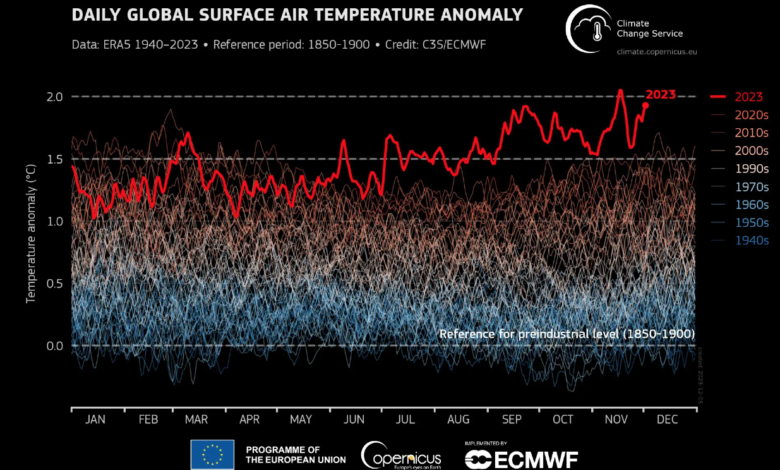Global warming soars: November to +1.75°C, 2023 is +1.46 ºC

Close to the global warming limit of 1.5 ºC set in Paris in 2015
– For the 5th month in a row, the average temperature of the Planet has exceeded the threshold of 1.5 degrees. And much. In November, global warming reached 1.75°C above the pre-industrial period, that is, the average of November between 1850 and 1900. And it pushed 2023 dangerously close to 1.5°C.
Another global warming record falls
From July to November, each month stood above the more ambitious limit set by the 2015 Paris Agreement. However, it is not enough 5 months (and not even a whole year) with these average temperatures to claim to have exceeded the threshold of 1.5 degrees. It is, in fact, a “goal” that must be calculated over several consecutive years.
But even with global warming accelerating, it could be closer than previously thought. The latest IPCC report published in 2021-22, and based on studies published until 2020, indicated as a likely date, at today’s emission rates, the mid-1930s. A study published in late October this year, using the same methodology as the IPCC but also adding the greenhouse gases generated in 2021-2023, anticipated the date to 2029.
The date is substantially confirmed also by the Global Carbon Project report published yesterday, in which it is fixed to 2030 the moment in which we will begin to exceed the 1.5 degrees continuously and for several years in a row.
Copernicus data for global warming in November 2023
The November 2023 global warming survey comes from the Copernicus Climate Change Service (C3S), the European satellite monitoring service that provides one of the most reliable datasets in the field.
On a global level, the average temperature of the Planet last month was 14.22 ºC. The deviation from the average of the last 30 years (1991-2020) is +0.85 ºC. An extremely significant figure because it is much higher than in all the previous months of November. The record of 2020 was surpassed by as much as 0.32°C.
More generally, November 2023 was the month with the second-largest thermal anomaly ever, considering any month of any year. More anomalous was only September 2023, when the distance from the average 1991-2020 reached +0.93°C.
Adding also the data of November, according to the calculations of Copernicus from January to today the global warming of 2023 reaches +1.46°C instead of the pre-industrial era. A value never reached before and 13 cents higher than that reached in 2016, still the hottest year ever since the beginning of systematic surveys.
Without greenhouse gas cuts there will be no turnaround
All this in a year characterized by El Niño, a phenomenon linked to the natural variability of the Earth’s climate that is estimated to add 0.1-0.15°C of global warming, depending on its intensity. The current event is weaker, if not much, than 2015-2016.
“2023 has now had six record months and two record seasons. The extraordinary global temperatures in November, including two days warmer than 2°C compared to the pre-industrial ones, make 2023 the hottest year ever recorded in history“, comments Copernicus vice-director Samantha Burgess. “As long as greenhouse gas concentrations continue to increase, we cannot expect results other than those seen this year. The temperature will continue to rise, as will the impacts of heat waves and drought. Achieving net zero as soon as possible is an effective way to manage our climate risks,” adds European Service Director Carlo Buontempo.





